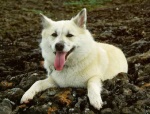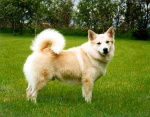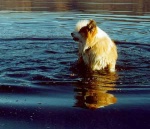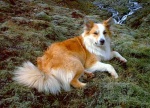History of the Icelandic sheepdog |
||
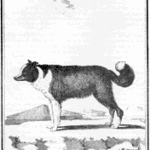 |
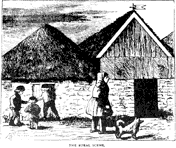 |
 |
| Illustration of an Icelandic sheepdog from count de Buffon`s “Historie Naturelle” | Engraving depicting “a rural scene”in Iceland | Photo from “das Unbekante Island” by Walther Herring 1936 |
The Icelandic Sheepdog is a spitz that originated in Scandinavia.
Dogs found in graves in Denmark and Sweden from about 8000 B.C. bear much resemblance with the Icelandic Sheepdog.
As norwegian Vikings set out to sea and colonized Iceland in 874, they brought their dogs with them. Throughout the years other breeds were only imported in small numbers, and since 1901 it has been forbidden to bring animals into Iceland, so the breed has to some extend remained pretty much the same since the Vikings settled down.
Epidemics, hunger periods and natural disasters have made life very harsh at times in Iceland, resulting in a breed that is tough and enduring .
The number of dogs has varied a lot over time. From the days of Ólaf Tryggvarsson (10th century) we have a written account telling about a famine that had quite seriuos consequenses for the dogs on the island: to remedy the situation a decision is made to kill all old folks and cripples, as they eat, but do not work.
The chief, Arnor Kærlingenef from Miklebø in Oslandshil has been among those in favour of this, but he is persuaded by his mother to rethink his decision. And after some discussion the decision is altered in favour of reducing the number of dogs and horses, which he announces in this speech:
“And no less shall this malpractice be done with, which has becomme common in these parts, that you feed dogs in such great numbers that many men could live on the food that they eat. Now we must kill these dogs, so that few or none shall live, and use the food previously given to the dogs to feed the people.”
Throughout the years the dogs have been looked upon in different ways. Sometimes hated, sometimes loved. A danish scientist, Peder Hansen Resen, gives this account in his description of Iceland in the 17th century: “Dogs are so much the joy of the natives, that hardly any are seen without being accompanied by a dog.”
A couple of hundred years later, another dane, Dr. Krabbe, visiting Iceland in 1880, gives this interesting account:
“Dogs may be indespensible for the icelander, but they also do much harm. They act as hosts for several species of intestinal worms, whose offspring can be transferred to humans and other animals, causing diseases among sheep and “liver-disease” in humans. This disease is so widespread that every 40th individual sufferes from it. It spreads mainly because of poor sanitary conditions, and because the number of dogs is so great.
The dog population varies in size, in 1855-56 an epidemic reduced the number of dogs greatly, and it has been said that as much as a cow or a couple of sheep was the price of a dog.
Now they are found in such great numbers that 2-5 dogs are found on each farm, sometimes even more. A priest told me that he had at least 12 dogs in his household that had come in the company of churchgoers and had been left behind. According to the icelanders it is not uncommon to have the service disturbed by dogs that run about and fight at the cemetary.”
Dr. Krabbe ends his account by recommending cut downs in the vast number of dogs in Iceland.
The “original” Icelandic Sheepdog survived only in very remote and isolated places, as other herding dogs where imported during the years in order to improve the herding instincts, and as the dog population as a whole was not looked kindly upon by the authorities, when the hygiene was taken more seriously.
As it is often the case it took another foreigner, the englishman Mark Watson, to open the icelanders’ eyes to the qualities of the original dog. Mr. Watson visited Iceland on many occasions between 1930 and 1970. In the 50’es he collected some of the best specimens to take abroad and breed in California. This aroused some concerned icelanders, and partly in collaboration with Watson, they started breeding on a small handful of carefully selected dogs.
With the foundation of the Icelandic Kennel Club in 1969 the main purpose was to watch over the Icelandic Sheepdog. The dog was seen as part of Icelands cultural heritage, and work is now being done to encourage sound breeding, and to seek out “new” dogs in remote locations.
With app. 5000 individuals registered worldwide (mainly in Scandinavia and northern Europe), the Icelandic Sheepdog is not a numerous breed, but is no longer on the brink of extinction.






